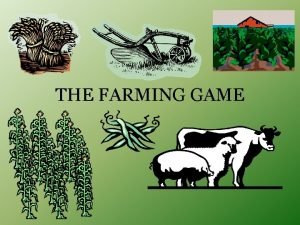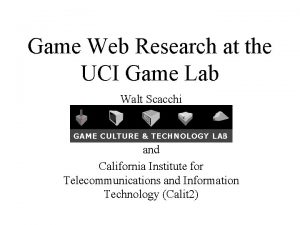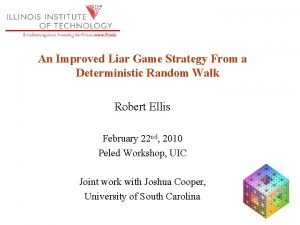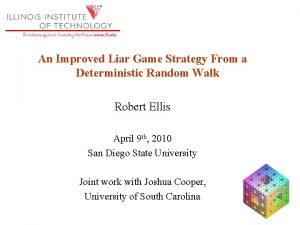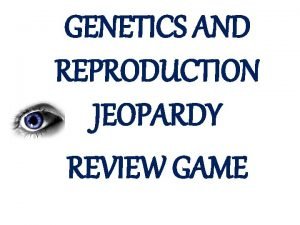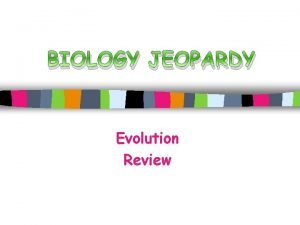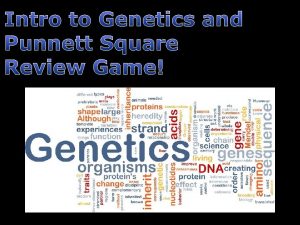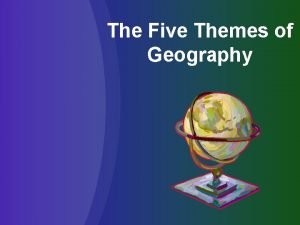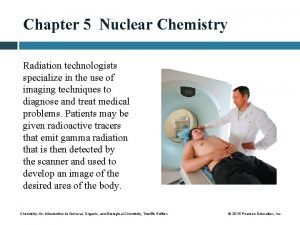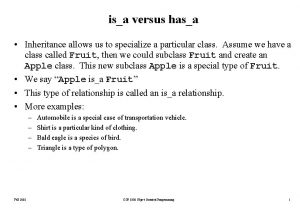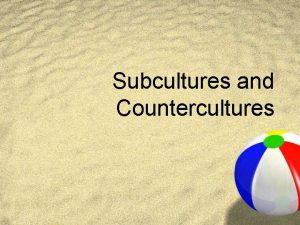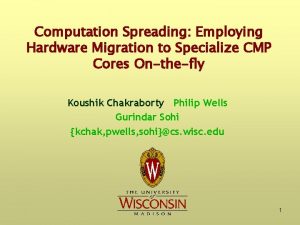Ch 17 Review Game Scientists who specialize in

























- Slides: 25

Ch. 17 Review Game

Scientists who specialize in the study of fossils are called • • • A Biologists B Paleontologists C Zoologists D Anthropologists Ans: B

Sedimentary rocks form when layers of small particles are compressed • • • A In the atmosphere B In a snow field C In mountains D Under water Ans: D

Radioactive dating of rock samples • • • A Is a method of absolute dating B Is a method of relative dating C Forms a geologic column D Forms a geologic time scale Ans: A

Half-life is the length of time required for half the atoms in a radioactive sample to • • • A Decay B Double C Expand D Be created Ans: A

Earth’s first atmosphere contained little or no • • • A Hydrogen cyanide B Hydrogen sulfide C Nitrogen D Oxygen Ans: D

In Miller and Urey’s experiments with the origin of life-forms, electric sparks were passed through a mixture of gases to • • • A Simulate temperature B Simulate sunlight C Sterilize the gases D Simulate lightning Ans: D

Outlines of ancient cells that are preserved well enough to identify them as prokaryotes are • • • A Microfossils B Heterotrophs C Autotrophs D Phototrophic Ans: A

Which event occurred at the end of the paleozoic era? • • • A Coevolution B Mass extinction C Punctuated equilibrium D Convergent evolution Ans: B

The process that produces a similar appearance among unrelated groups of organisms is • • • A Adaptive radiation B Coevolution C Convergent evolution D Mass evolution Ans: C

As a group, the large-scale evolutionary changes that take place over long periods of time are called • • • A Macroevolution B Coevolution C Convergent evolution D Geologic time Ans: A

Which of the following is characteristic of an index fossil? I. Distinctive species II. Lived in a wide geographic range III. Lived for a long period of time A. I only B. II only C. I and II only D. II and III only Ans: C

In which geologic era do you live? • • • A Cenozoic B Mesozoic C Cambrian D Precambrian Ans: A

The endosymbiotic theory includes all of the following EXCEPT • A Photosynthetic prokaryotes evolved into chloroplasts • B Aerobic prokaryotes evolved into mitochondria • C Eukaryotic cells arose from the merging of different prokaryotic organisms • D All organelles evolved from specialized enfoldings of the plasma membrane • Ans: D

Which of the following is evidence for the endosymbiotic theory? I. Mitochondria and chloroplasts contain DNA similar to bacterial DNA II. Mitochondria and chloroplasts contain ribosomes that differ from bacterial ribosomes III. Mitochondria and chlorplasts reproduce by binary fission a. I only b. II only c. I and III only d. II and III only Ans: C

While the planet was in a melted state, the most dense elements formed Earth's • • • A crust B core C oceans D atmosphere Ans: B

Most fossils form in • • • A rusty water B volcanic rock C sedimentary rock D the sap of ancient trees Ans: C

To be useful as an index fossil, a species must have existed for a • • • A long period over a wide geographic range B long period over a small geographic range C short period over a wide geographic range D short period over a small geographic range Ans: C

Miller and Urey’s experiments attempted to demonstrate • A how Earth first formed • B whether DNA or RNA evolved first • C whether organic molecules could have formed before life was present • D how the deepest part of the Earth was formed. • Ans: C

The endosymbiotic theory proposes that eukaryotic cells arose from • • • A individual prokaryotic cells B multicellular prokaryotes C communities formed by prokaryotes D communities formed by eukaryotes Ans: C

When oxygen was first released int eh early seas, it combined with iron to form • • • A RNA B DNA C proteins D rust Ans: D

Which of these facts about mitochondria and chloroplasts constitute(s) support for the endosymbiotic theory? • A Their DNA resembles bacterial RNA • B Their ribosomes resemble the ribosomes of bacteria • C They have organelles that are found within plant cells • D all of the above • Ans: D

The process by which two species, for example, a flower and a pollinating insect, evolve in response to changes in each other over time • • • A convergent evolution B adaptive radiation C coevolution D punctuated equilibrium Ans: C

A single species that has evolved into several different forms that live in different ways has undergone • • • A adaptive radiation B coevolution C punctuated equilibrium D mass extinction Ans: A

One way master control genes, or hox genes, could have affected evolution is • A by causing mutations in other genes within the genome • B through small changes during embryonic development that led to different body plans • C through the coevolution of species • D by leading to convergent evolution • Ans: B
 Why do people specialize and trade?
Why do people specialize and trade? Pirate game sheet
Pirate game sheet Farming game rules pdf
Farming game rules pdf A formal approach to game design and game research
A formal approach to game design and game research Game lab game theory
Game lab game theory Liar game game theory
Liar game game theory Liar game game theory
Liar game game theory Trash ball game
Trash ball game Romeo and juliet act 1 jeopardy
Romeo and juliet act 1 jeopardy Genetics jeopardy review game
Genetics jeopardy review game What is gettysburg
What is gettysburg Evolution jeopardy review game
Evolution jeopardy review game The reason the hypodermis acts as a shock absorber is that
The reason the hypodermis acts as a shock absorber is that Ww1 jeopardy
Ww1 jeopardy Punnett square game
Punnett square game Transformations review game
Transformations review game Domain co domain and range of a relation
Domain co domain and range of a relation Literary terms review game
Literary terms review game Trashketball directions
Trashketball directions 5 themes of geography review game
5 themes of geography review game Parts of speech review game
Parts of speech review game What is he doing
What is he doing Cell organelle jeopardy
Cell organelle jeopardy Ap world history jeopardy review game
Ap world history jeopardy review game Fill in the blank to make the statement true
Fill in the blank to make the statement true World history final exam study guide
World history final exam study guide


